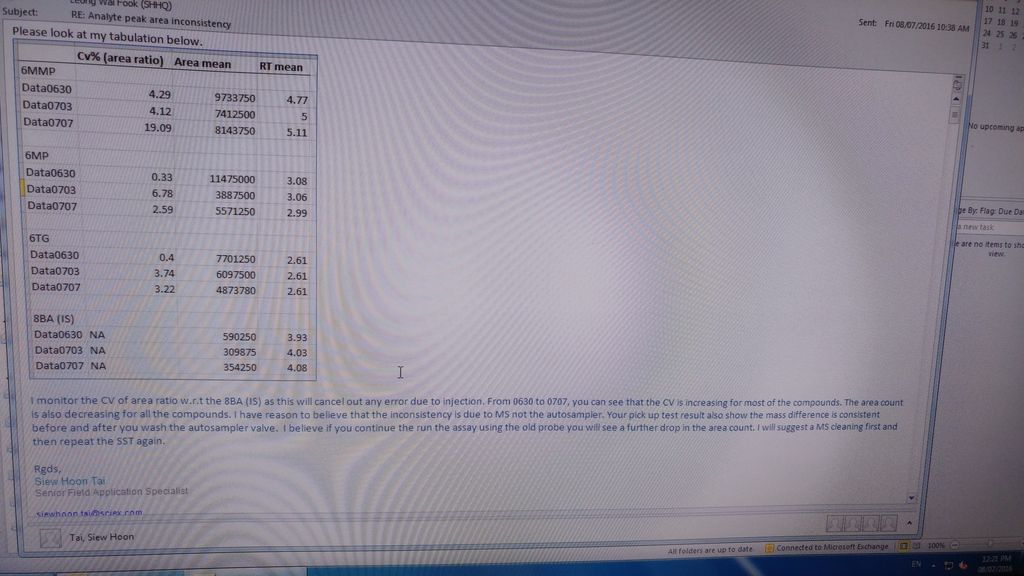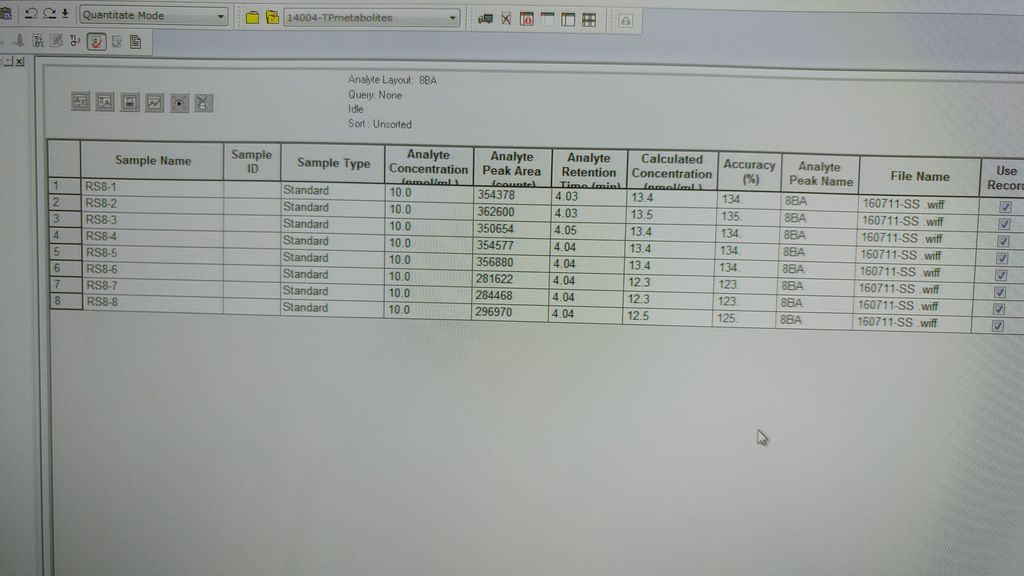Page 2 of 2
Re: Decreasing Peak Area, poor reproducibility
Posted: Thu Jul 07, 2016 2:18 pm
by Peter Apps
Hi Madeline
The 2 x 4 test eliminates vacuum in the vial as a source of the problem.
If there was something wrong with injection volume repeatability it would affect all peaks equally.
The progressive deterioration in performance makes me think that it is indeed an MS problem.
Peter
Re: Decreasing Peak Area, poor reproducibility
Posted: Thu Jul 07, 2016 2:28 pm
by tkubowicz
Hello
It is getting more and more complicated...
Have you got any UV detector with this system (or any in the lab)? Try method with UV detector to narrow it down and confirm if it is (or not) MSD problem
If it is problem with injection precision I'd recommend to take a look on sampler. Make sure that rotor seal is not worn out and loop is filled the same way with every singe injection.
Regards
Tomasz Kubowicz
Re: Decreasing Peak Area, poor reproducibility
Posted: Thu Jul 07, 2016 3:26 pm
by MaddyMadeline
It does affect all the analytes somehow in different degrees. Even though the last analyte was within 5% it wasnt as good as in the past whereby I can get it below 3%
I did clean the rotor seal as well and it doesn't seem worn out to me. The LC does have a diode array so I could link it up though I haven't used it before.
I just find it odd that it is the MS especially since it was certified to be working properly just 3 weeks ago and I haven't ran any other assay on it since then.
I have made the service call and the engineer is coming down tomorrow to do rail cleaning. I will update again.
Thank you guys for your help and advices. I really do appreciate it.
Madeline
Re: Decreasing Peak Area, poor reproducibility
Posted: Fri Jul 08, 2016 4:36 am
by MaddyMadeline

Thought I let you guys know how it is going. These are data from 3 different days.
Re: Decreasing Peak Area, poor reproducibility
Posted: Fri Jul 08, 2016 6:52 pm
by James_Ball
Seems like a lot of variation on the late eluting peak. That would only be effected by mobile phase/pump problems most likely.
Re: Decreasing Peak Area, poor reproducibility
Posted: Mon Jul 11, 2016 8:15 am
by MaddyMadeline
The rail cleaning didn't help. Now 2 analytes are giving high CV%. That analyte that was previously fine is showing peak area variations as well.
Re: Decreasing Peak Area, poor reproducibility
Posted: Mon Jul 11, 2016 10:24 am
by MaddyMadeline

This is my latest result after the rail cleaning. All the analytes are within CV 5% in fact even below 2% but this particular analyte 8-BA which is my internal standard is still over 10% because of thr sudden drop in peak area after 5 injections.
I doubt is the mobile phase? The baseline intensity for all analytes is <200
Re: Decreasing Peak Area, poor reproducibility
Posted: Mon Jul 11, 2016 2:24 pm
by James_Ball
If you double the number of injections, does the intensity continue to decrease?
I have one method that it takes about 10 injections before everything becomes stable.
Are you running Isocratic or Gradient? If Gradient, the later peaks could have retention time shifts and possibly area shifts if the percentages of solvents are not accurate or reproducible.
Re: Decreasing Peak Area, poor reproducibility
Posted: Tue Jul 12, 2016 2:01 am
by MaddyMadeline
Hi James,
This result was taken after over 40 injections, meaning there were 40 injections in front of it.
Typically when I do SST it goes like this :
20 injections same vial of QCH- highest QC sample at 40uM to stabilize the
system
10 injections same vial of RS8- highest calibration curve standard 50uM
RS1- lowest standard 0.25uM
Blank
Zero
4 blanks- just mobile phase in vial
8 injections same vial of RS8, RS8-1 to RS8-10( which I have attached the pic on previous post).
After over 40 injections, it should have stabilize. And the peak area will increase, decrease and then increase again depending so its not consistent. Sometimes it will decrease then increase.
I'm running isocratic mode
Re: Decreasing Peak Area, poor reproducibility
Posted: Tue Jul 12, 2016 3:06 am
by MaddyMadeline
Hi James,
If I double the injections, I believe it will stabilize will then decrease again. I noticed that after I inject a different concentration or I added in blanks, it will sort of reset then increase and decrease in peak area. It does up and down.
This result was taken after over 40 injections, meaning there were 40 injections in front of it.
Typically when I do SST it goes like this :
20 injections same vial of QCH- highest QC sample at 40uM to stabilize the
system
10 injections same vial of RS8- highest calibration curve standard 50uM
RS1- lowest standard 0.25uM
Blank
Zero
4 blanks- just mobile phase in vial
8 injections same vial of RS8, RS8-1 to RS8-10( which I have attached the pic on previous post).
After over 40 injections, it should have stabilize. And the peak area will increase, decrease and then increase again depending so its not consistent. Sometimes it will decrease then increase.
I'm running isocratic mode
Re: Decreasing Peak Area, poor reproducibility
Posted: Thu Jul 14, 2016 1:30 am
by MaddyMadeline
Problem still has not solved. AbSciex had came over to replace the Q1 Jet and also the lens but instead the problem has worsened? THe vaccum base pressure is 0.6 on standby.
One analyte which is 6MMP has now very short peaks although the CV% is below 5% It used to have peak areas of intensity to 10e5, now it is 10e4
Previously before the change only 8BA(internal standard) was having high CV%, now all my other analytes wither 6TG or 6MP are taking turns in having high CV% together with 8BA, so now I am having 2 analytes that have high CV% instead of 1.
Any ideas on what is happening, its a major problem for us. This problem seem to direct that there is really something wrong with the MS detector.
Re: Decreasing Peak Area, poor reproducibility
Posted: Tue Jul 19, 2016 4:20 pm
by MaddyMadeline
My problem is still not solved but ABSciex is now questioning about the method in which I am running the assay because its in isocratic mode. They came down to check my system using their standard analyte reserpine on their column and ran gradient mode and said my system was fine, CV% was fine.
They also ran my analytes on their column using gradient method and it was fine too so they are now pin pointing on my method and asking me to change it because apparently there is carry over effect.
Typically I wouldn't mind changing it if I am in a research lab but I am in a clinical lab so changing a validated method requires a lot changes in paperwork, validation and also SOP
And it makes no logic that a method will fail after 2 years of running smoothly plus the method is based off one that was developed by Prometheus Laboratories:
http://www.clinchem.org/content/51/11/2074.full
Our assay is based off this method almost to 100%, the parameters and even sample extraction is exactly the same. The only difference is that they are using an agilent 1100 HPLC and Absciex API 200 whereas I am using an Agilent 1290 UHPLC and AbSciex Qtrap 5500
Re: Decreasing Peak Area, poor reproducibility
Posted: Tue Jul 19, 2016 5:22 pm
by Peter Apps
Madeline, you can address the carryover problem without changing the method by running a gradient method with no injection between sample runs. This will double the number of runs, but will be no worse than doing multiple injections of high standards to "load the system" before you start running samples.
Peter
Re: Decreasing Peak Area, poor reproducibility
Posted: Thu Jul 21, 2016 8:30 am
by MaddyMadeline
Hi Peter,
I decided not to flush in between each injection as it will take too long plus my boss told me this cannot be a long term solution.
What I did was to remove the first guard column, we had 2 guard columns( I know its weird but assay was set up like this) so its left with just one guard and analytical column, changed the tubings between the autosampler and LC as well as those on the MS. I have also used the water provided by Ab Sciex to make my mobile phase.
After all these, my CV% has gone to below 5% which is great but it does still have some carryover effect but its not as bad as before. According to ABSciex, it could have been a multiple issues happening at the same time which is why its hard to trace the source. They are planning to replace the parts in the LC as well as those in the autosampler
Re: Decreasing Peak Area, poor reproducibility
Posted: Sun Jul 24, 2016 3:19 pm
by serga01net
In some cases, when working at low-ppb levels of active analytes (which can interact with LC column packing) such high CV% quite normal. To prevent dynamic interaction with LC column packing material (silica, as usual) additives to mobile phase (MP) are required. The main problem here - interaction of nitrogen containing analyte with ionized silanol group (-OH) on silica surface. When you run 20 "high level" analyte samples, a saturation of active sites occurs (for a short period of time). But captured analyte molecules constantly washed out from the packing. This phenomena depends strongly on pH of MP, column ageing and quality as well. "Quite inert" LC column doesn't exist in nature, so it's a big problem not only for you.

